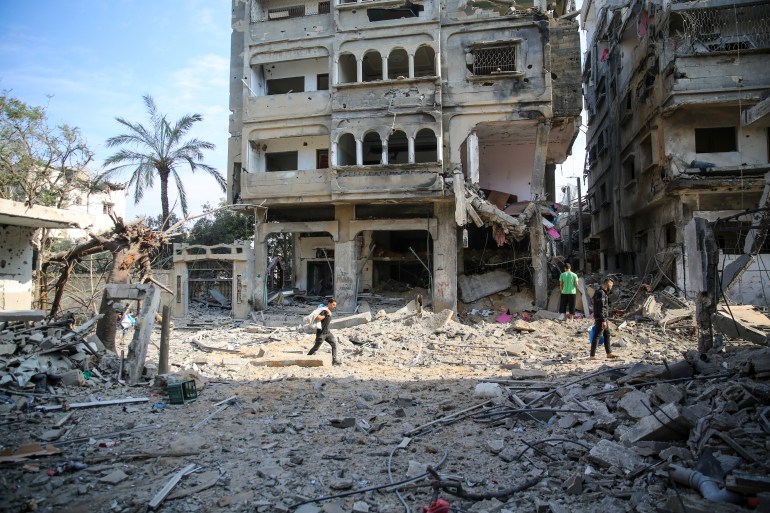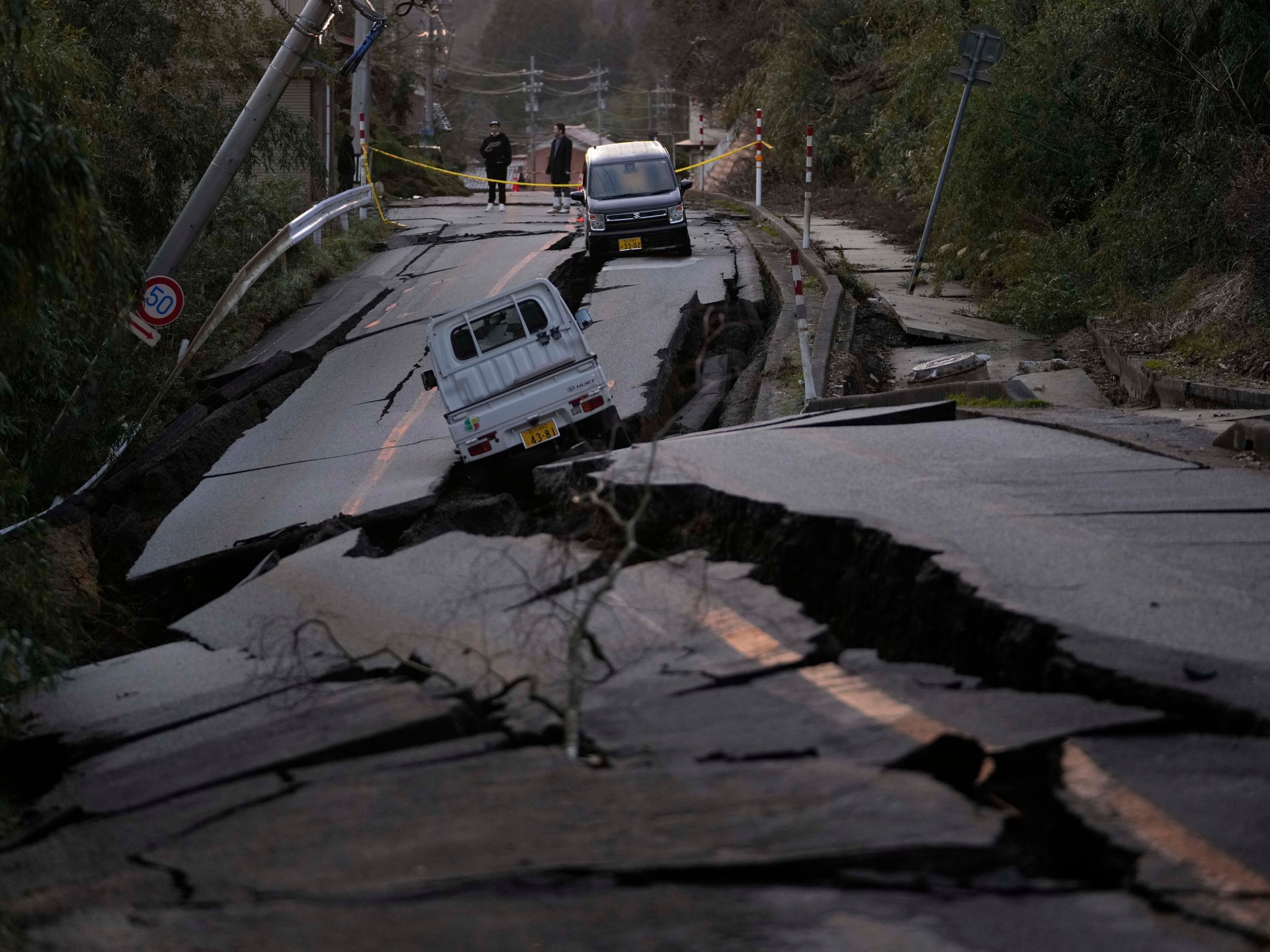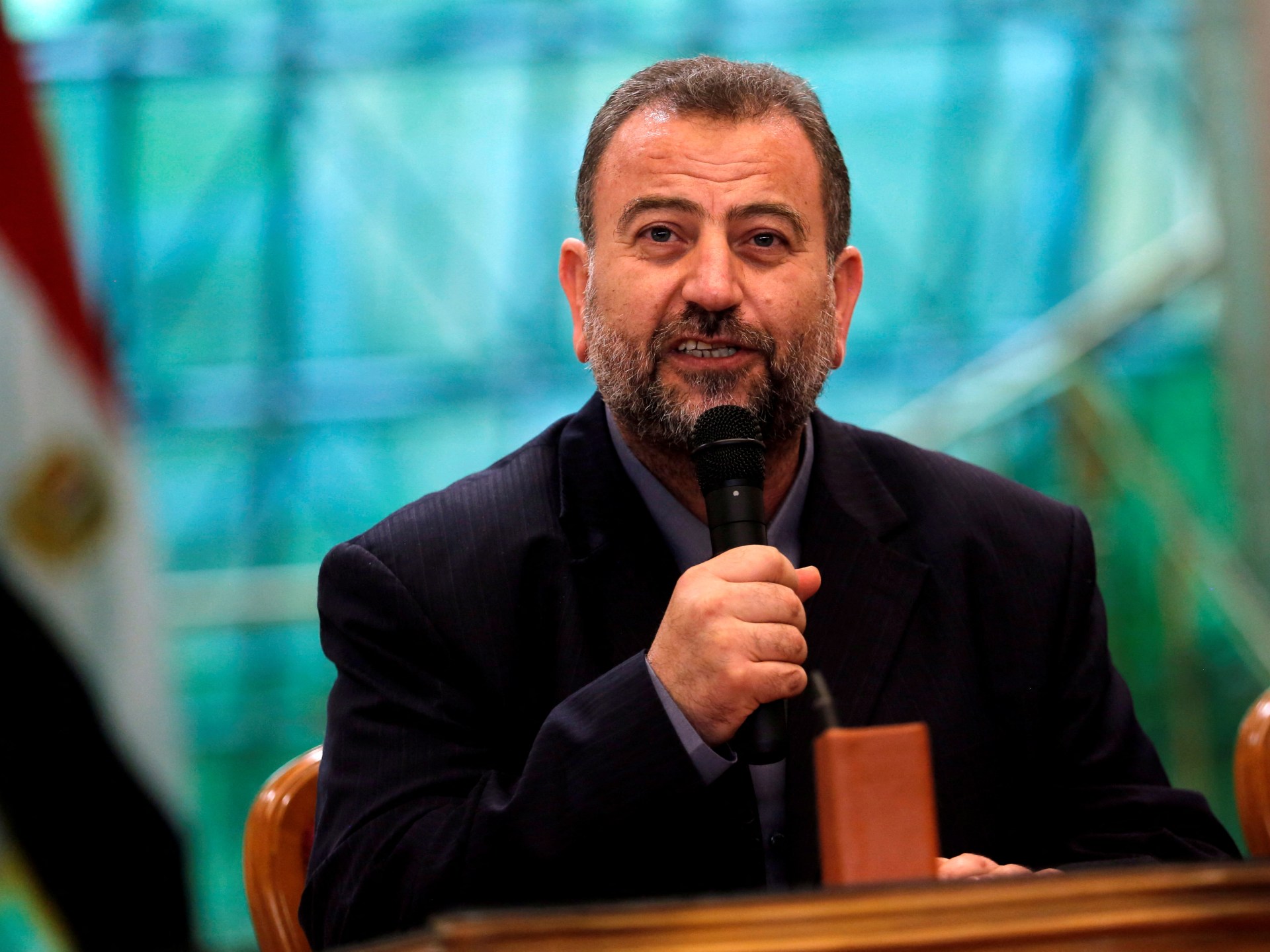A few days after Israel’s war on the Gaza Strip began, Israeli army spokesman Daniel Hagari admitted freely that the emphasis of the heavy bombardment of the besieged coastal enclave “is on damage and not accuracy”.
A day later, on October 11, the Israeli army boasted that 6,000 bombs weighing a combined 4,000 tonnes had been dropped on Gaza, one of the world’s most densely populated regions where 2.2 million people live on a 365sq-km (140sq-mile) strip of land.
That is nearly the equivalent of the bombs dropped on Afghanistan by NATO in one year, according to former United Nations war crimes investigator, Marc Galasco.
People fled, terrified, from the bombs, either because their homes had been hit or because their neighbours were killed in a bombing and they were worried they were next.
In the middle of the bombs raining down on Gaza and people trying to get away from them, the Israeli army issued an ultimatum on October 13: Everyone in northern Gaza was told to move south.
A large movement of people began, in cars, in trucks, and on foot, people were trying to get away, hoping to find safety.
But that very day, convoys of people moving south were bombed, killing at least 70 people and wounding more than 200.
![[Abdelkarim Hana/Al Jazeera]](https://www.aljazeera.com/wp-content/uploads/2023/10/M60A8211-1697369142.jpg?w=770&resize=770%2C513) Gaza City [Abdelkarim Hana/Al Jazeera]
Gaza City [Abdelkarim Hana/Al Jazeera]
‘Yousef was bleeding so much’
The Palestinian health ministry said one Palestinian has been killed in Gaza every five minutes in the current attacks.
At least 45 three-generation families have been killed, wiped from the civil registry, the ministry added.
The air in Gaza, Palestinians have said, is filled with the smell of spent ordnance and the stench of rotting bodies buried under the rubble of bombed homes.
More than 2,700 Palestinians have been killed, and at least 8,700 others injured since October 7.
Most of the eight refugee camps in the Gaza Strip, where more than 1.1 million registered refugees live, have been targeted by Israeli warplanes, massacring entire families.
The camps were more densely populated than usual, as people fled there to stay with friends or relatives, believing that Israel would not target such densely populated areas where refugees lived.
The Jabaliya refugee camp – population 35,000 – has been bombed several times, two of which are now known as the Ternis and Sikka Massacres.
On Monday, at the lively market intersection known as al-Ternis, two Israeli missiles killed dozens of people.
Survivors spoke of limbs flung about and the death toll, according to media, ranged from 60 to 70 people killed.
Iyad Islim had fled his home in Beit Hanoun, in the northern Gaza Strip and had come to stay with relatives in Jabaliya.
 Gaza City [Abdelkarim Hana/Al Jazeera]
Gaza City [Abdelkarim Hana/Al Jazeera]
“I thought that the camp would be a safer option because it is so full of people, and I thought it wouldn’t be targeted by Israeli planes,” the 37-year-old told Al Jazeera.
On that Monday, Islim went to the market to buy food and other necessities for his children. He was talking to a friend about the heavy bombardment Beit Hanoun was facing when a huge explosion ripped through the ground.
Thick heavy smoke covered the sky, and the sounds of people screaming filled the air.
“I saw terrifying scenes of dismembered bodies,” Islim recalled. “Men, women, and children. I couldn’t bear it … I broke down.”
The entire camp came running to the market, with screams and shouts rising whenever someone identified the body of their loved ones, some of them collapsing and fainting at the spot.
Rana Rajab was one of those people. She ran from her home searching for her three sons Mohammed, Khaled, and Louay who were in the market at the time of the explosion.
She found Mohammed trying to give first aid to his friend Yousef, who was badly injured.
“I tried to comfort him, but Mohammed kept saying ‘Let me go, I want to go with Yousef,'” she said.
![[Abdelkarim Hana/Al Jazeera]](https://www.aljazeera.com/wp-content/uploads/2023/10/ABDH9131-1697368894.jpg?w=770&resize=770%2C513) The site of al-Karameh Towers in the northern Gaza Strip [Abdelkarim Hana/Al Jazeera]
The site of al-Karameh Towers in the northern Gaza Strip [Abdelkarim Hana/Al Jazeera]
“I cried, there was so much blood … Yousef was bleeding so much.”
Her other two sons Khaled and Louay, visibly shaken, found Rajab and told her they had seen death.
“I have never felt such intense fear,” Raja said. “I didn’t expect this bombing. Everyone in the camp is shell-shocked.”
On Wednesday, Israel air raids targeted al-Sikka in Jabaliya, killing dozens of people.
“The camp was still reeling from the Ternis massacre,” said Ahmad Salem, whose neighbours were all killed in the attack.
“My family is in shock,” he said. “We lost our friends, our neighbours, the beautiful memories we shared together.”
“They wiped out everything … the buildings are all destroyed. Do the Israelis think all this destruction will displace us again?
“I will never leave my home. My children and I are staying here.”
Shati (Beach) refugee camp west of Gaza City, has been targeted by Israeli raids several times, terrifying the 90,000 refugees living on 0.52sq km (0.2sq miles).
Adel Khalaf, 63, was left bewildered by the Israeli planes targeting the camp’s mosques, the al-Sousi, al-Gharbi and the Ahmad Yasin.
“These are houses of worship,” he said.
“Why were they targeted? This began with Jewish settlers violating Al-Aqsa Mosque compound in Jerusalem, and now they are bombing mosques in Gaza.”
![[Abdelkarim Hana/Al Jazeera]](https://www.aljazeera.com/wp-content/uploads/2023/10/ABDH9145-1697368932.jpg?w=770&resize=770%2C513) Al-Karameh Towers in the northern Gaza Strip [Abdelkarim Hana/Al Jazeera]
Al-Karameh Towers in the northern Gaza Strip [Abdelkarim Hana/Al Jazeera]
The mosques stood in the middle of the camp, resulting in a lot of damage to the surrounding homes, which stand closely packed together because of how densely populated the camp is.
“The bombings have terrorised the children,” Khalaf said. “We picked up all the burned copies of the Quran off the ground and it was clear that the Israeli objective is causing as much destruction as possible.”
Another Shati resident, Saeed Lulu, said, “The attack knocked my wife to the floor from the force of the explosion.”
He added that it was painful to see the mosques being bombed.
“Israel has targeted our camp in previous wars,” he continued, “but this one is particularly devastating. We all struggle with this psychological trauma, as do our families. But we will persevere and are confident of victory.”
The southern Gaza refugee camp of Khan Younis – population 35,000 – has swollen in numbers in recent days as thousands of people streamed in from the north of the Strip.
“My family and I were displaced to relatives’ house in the camp,” Mohammed Rabie said. “On the fourth night, Wednesday, the house directly across the narrow lane from ours was hit.”
![[Abdelkarim Hana/Al Jazeera]](https://www.aljazeera.com/wp-content/uploads/2023/10/M60A8122-1697369084.jpg?w=770&resize=770%2C513) Gaza City [Abdelkarim Hana/Al Jazeera]
Gaza City [Abdelkarim Hana/Al Jazeera]
The bombing was so intense that the door to the house Rabie and his extended family were in was welded shut and they could not get out.
“We called our relatives to come rescue us, but they didn’t hear us because everyone was screaming that our neighbours, the Abu al-Rish family, were under the rubble of their home. At least seven of them were killed.”
Rabie’s family finally managed to leave the house after neighbours broke down the door.
“There’s more than 40 of us,” he said. “We’re still in disbelief that we survived this attack. That same night, we divided each other up and stayed with different relatives, so if there was another attack, we wouldn’t all be killed.”
“The scariest thing is the warplanes returning to target the same place when ambulances and people gather,” said Amal Barbakh, another neighbour of the Abu Rish family.
There is no safe place in the Gaza Strip, she said sadly.
![[Abdelkarim Hana/Al Jazeera]](https://www.aljazeera.com/wp-content/uploads/2023/10/ABDH9170-1697369022.jpg?w=770&resize=770%2C513) Al-Sikka intersection in Jabaliya refugee camp [Abdelkarim Hana/Al Jazeera]
Al-Sikka intersection in Jabaliya refugee camp [Abdelkarim Hana/Al Jazeera]

 Movie
Movie 6 months ago
111
6 months ago
111 






![Presidents Day Weekend Car Sales [2021 Edition] Presidents Day Weekend Car Sales [2021 Edition]](https://www.findthebestcarprice.com/wp-content/uploads/Presidents-Day-Weekend-car-sales.jpg)



 English (United States)
English (United States)